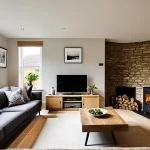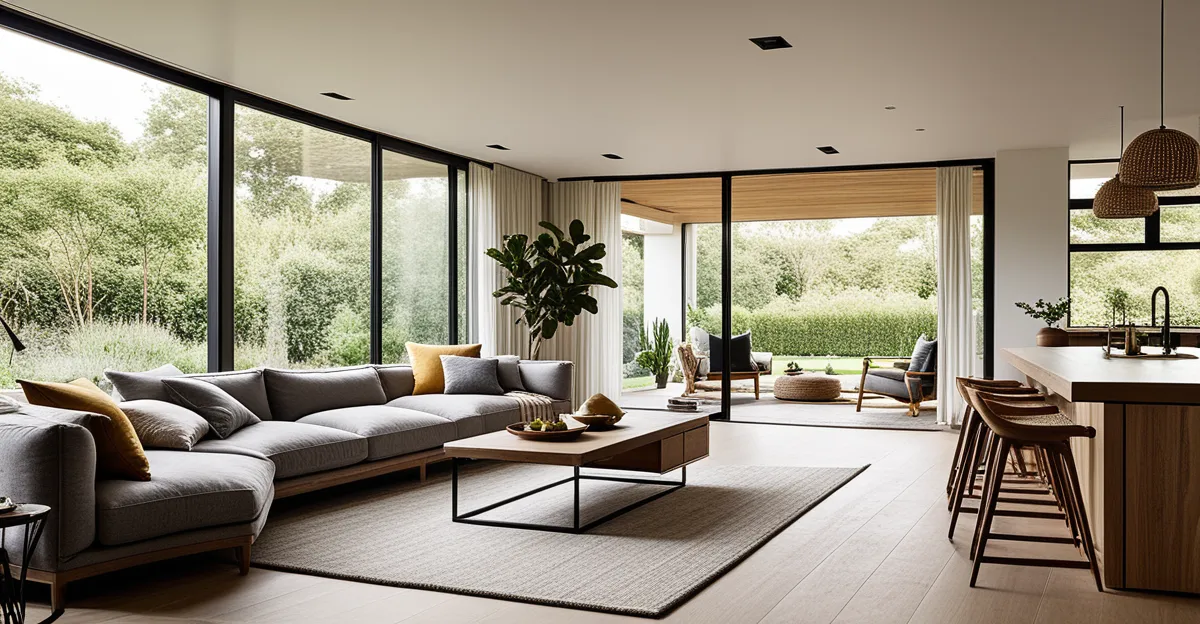Practical Eco-friendly Upgrades for Increased Comfort
Enhancing home comfort while embracing eco-friendly home upgrades begins with implementing practical, sustainable choices that cut energy use and waste. Installing a smart thermostat is a prime example. This device learns your schedule and adjusts heating or cooling accordingly, reducing energy consumption without sacrificing comfort. Alongside this, switching to energy-efficient lighting, such as LED bulbs, contributes to lower electricity bills and a smaller environmental footprint.
Improving your home’s insulation offers another effective way to maintain steady indoor temperatures year-round. Proper insulation minimizes heat loss during winter and keeps interiors cool in summer, which supports energy-efficient solutions by lessening the need for constant heating or air conditioning.
Also read : What Are the Key Trends Influencing UK Home Living Today?
Water-saving fixtures in kitchens and bathrooms are also integral to sustainable home improvement. Low-flow faucets and showerheads reduce water waste without compromising user experience. These upgrades enhance comfort while promoting responsible resource use. Together, these strategies represent accessible, impactful ways to boost comfort and sustainability in any home.
Practical Eco-friendly Upgrades for Increased Comfort
Upgrading your home with eco-friendly home upgrades not only benefits the environment but also enhances your comfort. One of the most effective energy-efficient solutions is installing a smart thermostat. Smart thermostats optimize heating and cooling schedules, reducing energy waste while maintaining ideal temperatures. Alongside, switching to energy-efficient lighting like LED bulbs can significantly cut electricity costs and brighten your living space sustainably.
Have you seen this : How Can Innovative Storage Solutions Transform Your Home?
Improving insulation is another key sustainable home improvement. Proper insulation keeps your home warm in winter and cool in summer, minimizing reliance on heating and cooling systems. This upgrade leads to stable, year-round temperature control and lower energy consumption.
Water-saving fixtures further boost comfort sustainably. Installing low-flow faucets, showerheads, and dual-flush toilets can drastically reduce water usage without sacrificing performance. These upgrades enhance bathroom and kitchen comfort, aligning with eco-friendly home upgrades focused on conservation.
By integrating these practical, energy-efficient solutions, homeowners achieve a balanced environment that prioritizes both comfort and sustainability—a smart approach to responsible living.
Sustainable Materials That Combine Style and Environmental Responsibility
Choosing the right sustainable home materials is essential for achieving both eco-consciousness and aesthetic appeal. Reclaimed wood is a top choice; it reduces deforestation by repurposing existing timber. Bamboo, another eco-friendly furniture option, grows quickly and provides a durable, natural look. Recycled metal adds industrial flair while lowering the demand for virgin metals.
Non-toxic paints contribute significantly to healthier indoor air quality by eliminating volatile organic compounds (VOCs). Incorporating natural fiber textiles, such as organic cotton or wool, also supports this goal, adding texture along with sustainability.
For flooring, durable, low-impact options like cork, reclaimed hardwood, or linoleum provide longevity and style. These materials minimize environmental harm across their lifecycle.
Selecting these materials is a practical step towards green building materials that help minimize the ecological footprint of interior spaces. Together, they demonstrate that sustainable home improvement need not sacrifice style or comfort, offering responsible and attractive design choices.
Sustainable Materials That Combine Style and Environmental Responsibility
Selecting sustainable home materials is key to marrying style with eco-conscious values. Reclaimed wood, bamboo, and recycled metal stand out as excellent choices for eco-friendly furniture due to their durability and minimal environmental impact. Using reclaimed wood salvages valuable resources, while bamboo grows rapidly, making it a highly renewable option. Recycled metal lessens mining demands, supporting broader sustainable home improvement goals.
Non-toxic paints further contribute to healthier indoor air quality by avoiding harmful chemical emissions. These paints complement natural fiber textiles—such as organic cotton and hemp—that soften interiors while enhancing eco-friendly living spaces.
For flooring, durable and low-impact options like cork and sustainably harvested hardwood combine long-lasting performance with natural beauty. Cork flooring offers softness underfoot and excellent insulation, ideal for comfort and energy savings. Overall, these green building materials help create stylish, healthy homes that align with both aesthetic preferences and environmental responsibility—providing a practical, elegant foundation for modern sustainable living.
Practical Eco-friendly Upgrades for Increased Comfort
Upgrading to a smart thermostat is a cornerstone of eco-friendly home upgrades. It precisely adjusts heating and cooling based on occupancy and preferences, leading to substantial energy savings. Unlike traditional thermostats, smart versions use algorithms to avoid unnecessary heating or cooling, ensuring comfort while reducing waste. Paired with energy-efficient lighting such as LED bulbs, these devices form a robust system that slashes electricity consumption.
Improved insulation complements these energy-efficient solutions by maintaining consistent indoor temperatures throughout the year. Enhanced insulation materials reduce thermal transfer, minimizing heat loss in winter and heat gain in summer. This translates to less reliance on HVAC systems, lowering energy bills and carbon emissions.
In the kitchen and bathroom, water-saving fixtures offer a dual benefit of comfort and conservation. Low-flow faucets, showerheads, and dual-flush toilets deliver strong water pressure while significantly curbing water use. Incorporating these fixtures into your sustainable home improvement plan not only preserves resources but enhances user experience by maintaining functionality.
Together, these targeted upgrades create a comfortable, efficient, and environmentally responsible living space.
Practical Eco-friendly Upgrades for Increased Comfort
Small eco-friendly home upgrades can greatly enhance comfort while promoting sustainability. Installing a smart thermostat is one of the most effective energy-efficient solutions. These devices learn household patterns and adjust temperatures automatically, reducing energy waste while maintaining comfort throughout the day and night.
Lighting improvements also play a vital role. Switching to LED bulbs not only cuts electricity consumption but ensures bright, consistent illumination with minimal heat output. Together, smart thermostats and energy-efficient lighting create a foundation for a comfortable, greener home.
Upgrading insulation is critical for year-round temperature stability. Well-insulated walls and attics minimize heat exchange, meaning less reliance on heating and cooling systems. This significantly supports sustainable home improvement by lowering energy demands and utility costs.
Water-saving fixtures in bathrooms and kitchens further enhance comfort with eco-friendly design. Low-flow faucets and showerheads reduce water use, conserving a precious resource without sacrificing water pressure or convenience. Combined, these energy-efficient solutions showcase practical, impactful ways to boost home comfort responsibly.
Practical Eco-friendly Upgrades for Increased Comfort
Installing a smart thermostat remains one of the most impactful eco-friendly home upgrades. These devices learn your daily routine, automatically adjusting temperatures to reduce energy waste without compromising comfort. By using advanced algorithms, smart thermostats optimize heating and cooling cycles more precisely than manual controls, enabling substantial savings on utility bills. Pairing this with energy-efficient lighting, particularly LED bulbs, further enhances your home’s energy-efficient solutions by cutting electricity consumption and offering long-lasting illumination.
Upgrading insulation is crucial for sustainable home improvement focused on thermal regulation. Enhanced insulation materials—like spray foam or mineral wool—create tighter building envelopes, dramatically reducing unwanted heat transfer. This increased efficiency keeps your home comfortably warm in winter and cool during summer, lowering the demand on HVAC systems year-round.
Water-saving fixtures complement these improvements by enhancing bathroom and kitchen functions sustainably. Installing low-flow faucets, showerheads, and dual-flush toilets reduce water waste while maintaining strong pressure and ease of use. Integrating these fixtures supports both conservation goals and household comfort, completing a well-rounded approach to practical, eco-friendly home upgrades.
Practical Eco-friendly Upgrades for Increased Comfort
Integrating energy-efficient solutions like a smart thermostat with energy-efficient lighting dramatically enhances home comfort while reducing environmental impact. Smart thermostats learn daily patterns, adjusting temperatures precisely to avoid unnecessary heating or cooling. This fine-tuned control cuts energy consumption effectively. Meanwhile, LED bulbs provide bright, long-lasting illumination with minimal electricity use, creating a well-lit, comfortable atmosphere.
Improving insulation is another critical eco-friendly home upgrade that ensures stable indoor climates in every season. Upgraded insulation reduces heat transfer through walls and roofs, maintaining warmth in winter and coolness in summer. This decreases dependency on HVAC systems, leading to lower energy bills and reduced carbon footprint.
Water-saving fixtures also play a vital role in sustainable home improvement, enhancing comfort without compromising function. Low-flow faucets and showerheads maintain strong water pressure while significantly lowering water usage. These fixtures contribute both to eco-friendly living and user satisfaction by balancing resource conservation with everyday convenience. Together, these measures represent practical, impactful steps toward a more comfortable, sustainable home environment.









